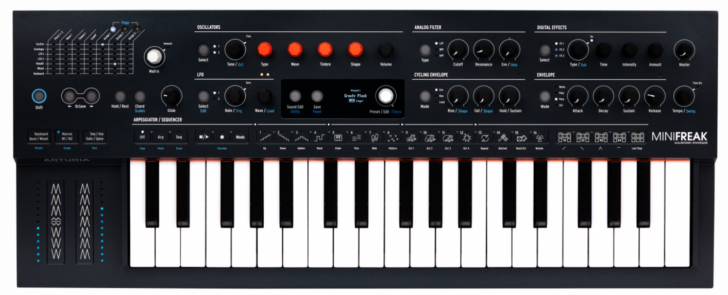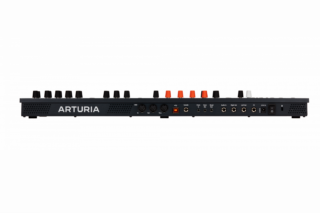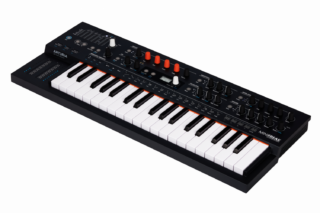Arturia has introduced the MiniFreak, a new hybrid polyphonic synthesizer that features 6 voices, 2 sound engines, a 37-note slim keyboard, built-in stereo FX, and numerous creative modulation & sequencing features.
Here’s the official intro video:
The MiniFreak also comes with a companion ‘like-for-like’ VST instrument, MiniFreak V, that you can use in your DAW.
Key Features:
- Hybrid polysynth power – MiniFreak’s twin digital sound engines feature over 20 modes, and can be used individually, stacked, or to process each other’s output for unique compound sonic behavior. Its digital voices then pass through analog filters, balancing digital crispness with a rich analog response, giving you 6-voice polyphony, 12-voice paraphony, monophonic, and unison configurations.
- Customizable & experimental sound design – MiniFreak’s expanded modulation matrix gives users even more control over shaping, transforming, and evolving their sound, with features like polyphonic ADSR envelopes, customizable multi-segment LFO shapes, FM & Ring Modulation, and the familiar Spice & Dice randomization.
- Mix-ready stereo sound – With stereo outputs and 3 digital FX slots with 10 FX types to choose from, users will have everything they need to push their sound over the edge while keeping it mix-ready, from stereo-enhancing chorus, to surgical 3-band EQ, to gritty distortion.
- Expressive PerformancerOptions – The MiniFreak offers a velocity-sensitive 37-note keybed with aftertouch and Seq/Arp functionality, plus randomization features.
- MiniFreak V – MiniFreak comes with a dedicated VST counterpart, letting users totally integrate its unique hybrid sound and presets into their DAW productions and vice versa. Using identical sound engines, modeled filters, presets, and synchronized controls, users can enjoy an identical experience in hardware or software form.
Features:
- 6-voice polyphonic hybrid synthesizer
- 37-note velocity-sensitive Slim-key keybed with aftertouch
- 2 sound Engines with 22 oscillator modes in total
- Engine 2 can be used to process Engine 1
- 1 envelope per voice
- 1 cycling envelope per voice
- 2 LFOs per voice
- Polyphonic analog filters and VCAs
- 6-voice polyphonic, 12-voice paraphonic, unison, or mono configuration
- 3 digital FX slots in insert or send mode, with 10 FX to choose from
- User-customizable LFO curves
- Mod Matrix with 7 sources and 13 potential destinations
- OLED display for real-time visual feedback
- Intuitive 64-step sequencer (4 pages of 16 steps)
- 4 lanes of automated modulation
- Performance Arpeggiator controls including Ratchet, Octave Randomize, and more
- MIDI in/out/thru
- USB connectivity
- Sustain, audio in, and clock in/out connectivity
- Stereo outputs
- 256 factory presets
- 256 user preset slots
Sound Engines:
- Noise
- Superwave
- Harmo
- Karplus Str.
- BasicWaves
- Audio In
- Multi Filter
- Surgeon Filter
- Comb Filter
- Phaser Filter
- Destroy
- FM/RM
- V.Analog
- Waveshaper
- Two Op. FM
- Formant
- Chords
- Speech
- Modal
- SawX
- Harm
- Bass
Effects:
- Chorus
- Phaser
- Flanger
- Reverb
- Delay
- Distortion
- Bit Crusher
- 3-Band EQ
- Peak EQ
- Multi Comp
Pricing and Availability
MiniFreak will be available for purchase from October 18th, 6PM CET, priced at 599€ / $599.





So I can spend $599 for hardware control or wait until they make the VST a part of V Collection. That’s an interesting approach and I appreciate being able to choose between the blue and red pill.
smart approach, giving you two options to choose from instead of having to choose if you want any of it.
Gadi, you’re always too cynical. Just because the instrument exists in hardware and software form doesn’t mean I will buy it. It just means that I think this trend of offering physical and virtual versions of new instruments is very clever.
Certainly shall be a classic of the future days
Soo much sound and possiblity squeezed into a neat package
I should maybe have waited a bit before I dropped my cash on a Modal Cobalt5s
Oops
Nice work Arturia!
OK, “Mini” after the “Micro” and on the other side there are the huge Matrix- and Poly-Brute Synths.
MiniFreak having internal effects is a big step up from the micro, would definately choose this over the MicroFreak however:
Hoped for a Medium sized Synth, with a Matrix that has buttons to push instaed of a led-menu.
Let’s see if the “Freak” series of synths grows further.
Funny Arturia only did Microminis or Flagships so far 🙂
I have the microfreak and love it – this does look really cool but……. I want to see if they continue the trend what a drum freak is
Hype! Take my money!
It will be very interesting to see how this sells. The Microfreak was quite tempting at it’s low price. This is the same price like Minilogue XD territory or Deepmind12. It’s also interesting a VST exists of it as well.
If the keybed on this is the same as on the Keystep-37, this may be worth looking at, especially for the price.
I will gladly take that VST if they let me buy it, not really interested in the hardware.
This one seems a lot less “freaky” and just seems like they added all the typical boring synth stuff people complained were missing from the original. Personally, I liked the uniqueness and relative simplicity of the original and I for one, am disappointed they did away with the capacitive keyboard. That said, it is still a cool synth, just not for me!
I know, right? The Microfreak has a less is more kind of vibe, and I also prefer the Microfreak “keys” to the Minifreak mini-keys. I hate mini-keys. IIMHO, mini-keys make any synth look like a toy.
i guess many complained about the touch keys, mostly on comment sections… mini or regular, to me any keys looks bad.
Me2. Its at least a good medicine against Gear Acquisition Syndrome.
Same, especially on the keyboard (not a fan of minikeys), but the changes are well thought out and the price is still competitive. I am just fine with Arturia and Korg dueling to serve the experimentally minded, both companies are doing a great job of balancing accessibility, capability, and affordability.
The Microfreak is still in a class of its own but this sounds good and will probably keep evolving. Very impressed with Arturia’s commitment to updates/expansions.
This is the Arturia Freak I’ve been dreaming of, I thought the PolyBrute was a missed opportunity when they already had a brilliant hybrid engine. So pleased they’ve finally made the MiniFreak, it has many features you won’t find in any other hybrid synth!
Two smart pluses: the bundled VST version, which is a welcome courtesy and the continued clock in/out for modular players. I like the overall step up from the Micro, with the dual engines and effects. Same with the retention of the control ribbon, now in 2 parts. The price seems fair, too.
I’m curious to see how the market takes to it. Its a strange creature of a synth. My bet is that we’ll be seeing one in every third tabletop rig by Spring. It’ll be a natural among Boutiques, Cobalt 5s and Dreadboxes. Available in the custom neon blue Nick Batt model and the hot purple Prince model.
This is the same price, 37 keys, as the Hydrasynth Explorer… Although this has the Polyphonic analog filters and VCAs, but the Explorer has polyphonic aftertouch, but this has a sequencer, but the Explorer mod matrix and mutators are amazing… I need someone who had tried both to compare!!!
Hydrasynth is awesome, the end. Wish it had a sequencer, the end. Pressing that random patch button a bunch of times until you get something that makes a melody just fall out of you, the end. Microfreak sounds awesome, lots of synth engines but the hydrasynth seems to have more control is a very very user friendly experience. Routing is a no brainer and if sound exploration is your thing, its the best for that. 2nd best for routing is the matrix/polybrutes. I liked the microfreak but I founds the limits while exploring. I never felt that way with the hydrasynth. BUT, the microfreak is very tempting but it wouldnt make sense to have both.
Remember when the only affordable starter synth was the microKorg?
Now there are so many great choices for starter synths – the miniFreak, the Hydrasynth Explorer, the PWM Malevolent, the Yamaha ReFace CS.
I didn’t feel Hydrasynth at all. Great features on paper, but the sound just didn’t do it for me. Microfreak is much less powerful in comparison, but has way more sonic character and mojo. Of course that’s ultimately a question of taste.
oooooooooooooooooooooooooooooooooooooooooooooooooooo
Looks and sounds great to me. I don’t care about the VST version. They’ve finally put out a portable unit I can take on family vacations with some built-in effects at a reasonable price. Presets sound like it covers a lot of bases. Shut up and take my money.
To add: Interface also looks fun and engaging and will hopefully interest my young daughter more than some of my monster synths.
I’m excited by this. I hope to get an Explorer first but this will also find a home. I like the additions compared to the MicroFreak. I hope they add the Wavetable oscillator back in though as that was one of my favourite parts of the OG unit.
I like myself this instrument as expander without the keys and the touch sliders to the left to save space, plus the vocoder function that has seemed to have fall off the design board in project meetings 🙂
I have too many small synths – so I’ll wait on this one – and see if they produce a 49 or 61 note full sized key version. Looks good otherwise.
I kinda wish they stuck to the OG. When they do a full keys version it will probably be too expensive as they’re selling this version for 599,- already
I got Minifreak in the mail today and spent an hour with it. My first thought was “future classic”: Perfect size, great balance between features and usability, a wide sonic range that covers all types of weird-ish sounds, good build quality and a whole lot of personality and character. I think a lot of people will grab one.
I like you’re hat, where can i get one?